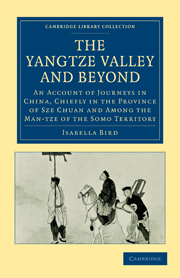 The Yangtze Valley and Beyond
The Yangtze Valley and Beyond Book contents
- Frontmatter
- PREFACE
- Contents
- LIST OF ILLUSTRATIONS
- ERRATA
- CHAPTER I GEOGRAPHICAL AND INTRODUCTORY
- CHAPTER II “THE MODEL SETTLEMENT”
- CHAPTER III HANGCHOW
- CHAPTER IV THE HANGCHOW MEDICAL MISSION HOSPITALS
- CHAPTER V SHANGHAI TO HANKOW (HANKAU)
- CHAPTER VI THE FOREIGNERS—HANKOW AND BRITISH TRADE
- CHAPTER VII CHINESE HANKOW (HANKAU)
- CHAPTER VIII HANKOW TO ICHANG
- CHAPTER IX ICHANG
- CHAPTER X THE UPPER YANGTZE
- CHAPTER XI RAPIDS OF THE UPPER YANGTZE
- CHAPTER XII RAPIDS AND TRACKERS
- CHAPTER XIII LIFE ON THE UPPER YANGTZE
- CHAPTER XIV THE YANGTZE AND KUEI FU
- CHAPTER XV NEW YEAR'S DAY AT KUEI-CHOW FU
- CHAPTER XVI KUEI FU TO WAN HSIEN
- CHAPTER XVII CHINESE CHARITIES
- CHAPTER XVIII FROM WAN HSIEN TO SAN TSAN-PU
- CHAPTER XIX SZE CHUAN TRAVELLING
- CHAPTER XX SAN-TSAN-PU TO LIANG-SHAN HSIEN
- CHAPTER XXI LIANG-SHAN HSIEN TO HSIA-SHAN-PO
- CHAPTER XXII HSIA-SHAN-PO TO SIAO-KIAO
- CHAPTER XXIII SIAO-KIAO TO HSIEH-TIEN-TZE
- CHAPTER XXIV HSIEH-TIEN-TZE TO PAONING FU
- CHAPTER XXV PAONING FU AND SIN-TIEN-TZE
- CHAPTER XXVI SIN-TIEN-TZE TO TZE-TUNG HSIEN
- CHAPTER XXVII TZE-TUNG HSIEN TO KUAN HSIEN
- CHAPTER XXVIII KUAN HSIEN AND CHENGTU
- CHAPTER XXIX KUAN HSIEN TO SIN-WEN-PING
- CHAPTER XXX SIN-WEN-PING TO LI-FAN TING
- CHAPTER XXXI LI-FAN TING TO TSA-KU-LAO
- CHAPTER XXXII THE “BEYOND”
- CHAPTER XXXIII THE MAN-TZE, I-REN, OR SHAN-SHANG-REN
- CHAPTER XXXIV FROM SOMO TO CHENGTU FU
- CHAPTER XXXV DOWNWARD BOUND
- CHAPTER XXXVI LUCHOW TO CHUNG-KING FU
- CHAPTER XXXVII THE JOURNEY'S END
- CHAPTER XXXVIII THE OPIUM POPPY AND ITS USE
- CHAPTER XXXIX NOTES ON PROTESTANT MISSIONS IN CHINA
- CONCLUDING REMARKS
- ITINERARY
- APPENDICES
- INDEX
- Plate section
CHAPTER XXVIII - KUAN HSIEN AND CHENGTU
Published online by Cambridge University Press: 05 July 2011
- Frontmatter
- PREFACE
- Contents
- LIST OF ILLUSTRATIONS
- ERRATA
- CHAPTER I GEOGRAPHICAL AND INTRODUCTORY
- CHAPTER II “THE MODEL SETTLEMENT”
- CHAPTER III HANGCHOW
- CHAPTER IV THE HANGCHOW MEDICAL MISSION HOSPITALS
- CHAPTER V SHANGHAI TO HANKOW (HANKAU)
- CHAPTER VI THE FOREIGNERS—HANKOW AND BRITISH TRADE
- CHAPTER VII CHINESE HANKOW (HANKAU)
- CHAPTER VIII HANKOW TO ICHANG
- CHAPTER IX ICHANG
- CHAPTER X THE UPPER YANGTZE
- CHAPTER XI RAPIDS OF THE UPPER YANGTZE
- CHAPTER XII RAPIDS AND TRACKERS
- CHAPTER XIII LIFE ON THE UPPER YANGTZE
- CHAPTER XIV THE YANGTZE AND KUEI FU
- CHAPTER XV NEW YEAR'S DAY AT KUEI-CHOW FU
- CHAPTER XVI KUEI FU TO WAN HSIEN
- CHAPTER XVII CHINESE CHARITIES
- CHAPTER XVIII FROM WAN HSIEN TO SAN TSAN-PU
- CHAPTER XIX SZE CHUAN TRAVELLING
- CHAPTER XX SAN-TSAN-PU TO LIANG-SHAN HSIEN
- CHAPTER XXI LIANG-SHAN HSIEN TO HSIA-SHAN-PO
- CHAPTER XXII HSIA-SHAN-PO TO SIAO-KIAO
- CHAPTER XXIII SIAO-KIAO TO HSIEH-TIEN-TZE
- CHAPTER XXIV HSIEH-TIEN-TZE TO PAONING FU
- CHAPTER XXV PAONING FU AND SIN-TIEN-TZE
- CHAPTER XXVI SIN-TIEN-TZE TO TZE-TUNG HSIEN
- CHAPTER XXVII TZE-TUNG HSIEN TO KUAN HSIEN
- CHAPTER XXVIII KUAN HSIEN AND CHENGTU
- CHAPTER XXIX KUAN HSIEN TO SIN-WEN-PING
- CHAPTER XXX SIN-WEN-PING TO LI-FAN TING
- CHAPTER XXXI LI-FAN TING TO TSA-KU-LAO
- CHAPTER XXXII THE “BEYOND”
- CHAPTER XXXIII THE MAN-TZE, I-REN, OR SHAN-SHANG-REN
- CHAPTER XXXIV FROM SOMO TO CHENGTU FU
- CHAPTER XXXV DOWNWARD BOUND
- CHAPTER XXXVI LUCHOW TO CHUNG-KING FU
- CHAPTER XXXVII THE JOURNEY'S END
- CHAPTER XXXVIII THE OPIUM POPPY AND ITS USE
- CHAPTER XXXIX NOTES ON PROTESTANT MISSIONS IN CHINA
- CONCLUDING REMARKS
- ITINERARY
- APPENDICES
- INDEX
- Plate section
Summary
Kuan hsien (2347 feet, Gill) is one of the best-placed cities in China, at the north-west corner of the Chengtu plain, immediately below the mountains which wall it in on the north, and, indeed, scrambling over their spurs just at the fine gorge of the Couching Dragon, from whence the liberated Min bursts in strength to gladden the whole plain. The Mien-chuh road has not a fine entrance into the city—the Chengtu road, which I travelled three times, approaches Kuan under six fine pai-fangs, elaborately, and, indeed, beautifully decorated with carvings in high relief in a soft grey sandstone.
Apart from its situation, it is an unattractive town, with narrow, dirty streets, small lifeless-looking shops, and a tendency to produce on all occasions a dirty crowd, which hangs on to a foreigner, and which on my arrival greeted me with—“Here's another child-eater.” It has an outpost air, as if there were little beyond, and this is partly true. It has a possible population of 22,000. It is not a rich city, and its suburbs do not abound in rich men's houses. But it is distinguished, first for being the starting point of the oldest and, perhaps, the most important engineering works in China; and secondly, as being a great emporium of the trade with Northern Tibet, which is at its height during the winter, when as many as five hundred Tibetans, with their yaks, are encamped outside its walls.
- Type
- Chapter
- Information
- The Yangtze Valley and BeyondAn Account of Journeys in China, Chiefly in the Province of Sze Chuan and Among the Man-tze of the Somo Territory, pp. 338 - 360Publisher: Cambridge University PressPrint publication year: 2010First published in: 1899


